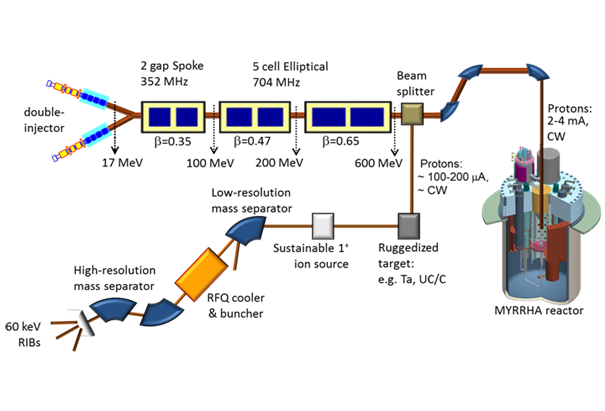Polonium-containing molecules in MYRRHA
Polonium-containing molecules in MYRRHA
Promotor(en): S. Cottenier, M. Sluydts /25380 / Solid-state physicsBackground and problem
MYRRHA is a new generation of nuclear fission research reactor that is inherently safe (no melt-down possible), and that can be used to produce electricity, to burn long-lived nuclear waste of the previous generations of fission reactors and to produce medical isotopes (here is an introductory talk on MYRRHA). It is being developed and built at SCK-CEN in Mol, supported by a large international consortium of scientists and engineers.

One of the many puzzles that need to be solved along the road, is how to deal with the unwanted generation of alpha-emitting Polonium isotopes, which eventually form volatile molecules in the cover gas above the liquid metal coolant of the reactor. Experimental studies have determined some properties of those molecules, but without being able to identify the composition and structure of the molecule. In this thesis, you will approach the project from the computational side by predicting the most likely molecule that would appear under the given conditions.
Understanding how this molecule looks like is important for developing the right filters to keep the Polonium concentration in the cover gas low.
Goal
There are several computational approaches possible to reach the goal, and which one will be used will depend on your preference and on the state of the topic when the thesis research starts. One possibility is to use Density Functional Theory in order to predict the composition and geometry of Tellurium-containing molecules. Tellurium is the lighter, less relativistic and non-radioactive analog for Polonium, for which the calculations are easier and for which more experimental information is known. This will allow to assess the reliability of this approach, after which it can be applied to Polonium-containing molecules. Another possibility is to train a machine learning potential for Polonium based on high-accuracy quantum chemistry input, including active learning. A third possibility is training a machine learning algorithm to learn the difference between DFT and quantum chemistry calculations for the same molecule, such that eventually the accurate quantum chemistry result can be predicted based on the faster DFT calculation.
Cooperation with company
Epotentia (epotentia.com) for machine learning support
List of figures:
Figure X: scheme of the MYRRHA reactor
- Study programmeMaster of Science in Engineering Physics [EMPHYS], Master of Science in Sustainable Materials Engineering [EMMAEN], Master of Science in Physics and Astronomy [CMFYST]Keywordsfission reactors, MYRRHA, polonium, density-functional theoryReferences
M.A.J. Mertens et al., J. Phys. Chem. Lett. 2019, 10, 2879−2884 (https://dx.doi.org/10.1021/acs.jpclett.9b00824)
E.A. Maugeri et al., Radiochim. Acta 2016, (https://dx.doi.org/10.1515/ract-2016-2573)
https://vimeo.com/326867869/3827b5c0c7
